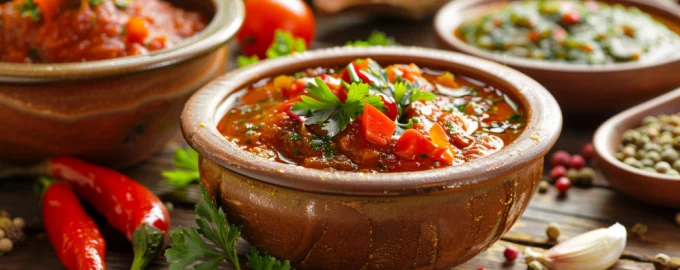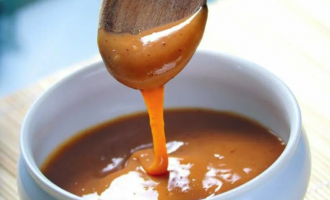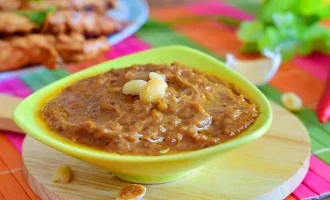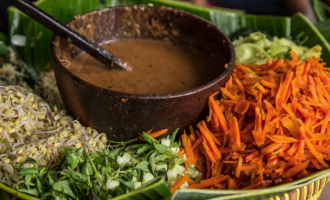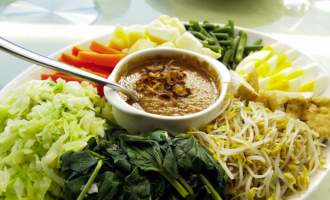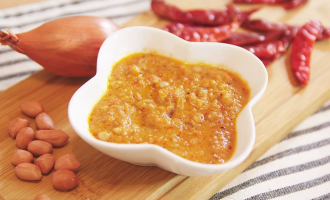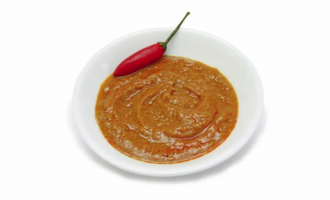Hamadari sauce, while not widely known under this specific name in global culinary lexicon, appears to be a reference to a type of nut-based sauce. For the purpose of this recipe, we’ll interpret “Hamadari” as a nod to Asian-inspired, nutty sauces, akin to what one might find in Vietnamese cuisine, where nut-based sauces are celebrated for their rich flavors and versatility. Vietnamese cuisine, in particular, is renowned for its use of peanuts and other nuts to create sauces that accompany everything from spring rolls to noodle dishes, offering a delightful blend of salty, sweet, sour, and spicy flavors. These sauces not only enhance the dishes they accompany but also provide a nutritional boost thanks to the nuts’ healthful fats, proteins, and minerals.
- Unsalted roasted peanuts 150 g
- Garlic cloves 20 g
- Fresh ginger 20 g
- Soy sauce 50 g
- Fish sauce 30 g
- Lime juice 30 g
- Brown sugar 50 g
- Coconut milk 100 g
- Water 50 g
- Crushed red pepper flakes 5 g
- In a food processor, blend the roasted peanuts until finely ground but not yet turned into butter. A bit of texture is desirable for this sauce.
- To the ground peanuts, add minced garlic, minced fresh ginger, soy sauce, fish sauce, lime juice, brown sugar, and coconut milk. Blend until the mixture is well combined but still retains some of the peanut’s crunchiness.
- While blending, gradually add water until you reach the desired consistency. It should be pourable but still thick enough to cling to foods.
- Add crushed red pepper flakes according to your taste preference for heat. Pulse a few more times to distribute the flakes evenly throughout the sauce.
- This sauce can be served immediately or stored for later use. It pairs wonderfully with grilled meats, spring rolls, noodles, or as a dressing for salads.
Storage Tips
Hamadari nut sauce can be stored in an airtight container in the refrigerator for up to one week. The flavors often meld and deepen over time, so making it a day ahead can enhance its taste. This sauce is not suitable for freezing as it may affect the consistency and flavor.
Useful Properties of the Main Ingredient
Peanuts, the main ingredient in this sauce, are a good source of healthy fats, protein, vitamins, and minerals, including biotin, copper, niacin, folate, manganese, vitamin E, thiamine, phosphorus, and magnesium. They’re also rich in antioxidants, which can help reduce inflammation and promote heart health.
Interesting Facts about the Sauce
- In Vietnamese cuisine, nut-based sauces are a testament to the culinary philosophy of balancing flavors and textures, adding depth to even the simplest of dishes.
- Peanuts, introduced to Vietnam by Portuguese and Spanish traders in the 16th century, have become a staple in Vietnamese cooking, showcasing the country’s ability to adopt and integrate foreign ingredients into its culinary traditions.
- The versatility of this type of sauce demonstrates its ability to transcend cultural boundaries, easily adapted to suit local tastes and preferences while maintaining its essential character.
This recipe for Hamadari sauce—interpreted here as a Vietnamese-inspired nut sauce—offers a deliciously rich and complex addition to a variety of dishes, highlighting the importance of nuts in Asian cuisine and their nutritional benefits.

